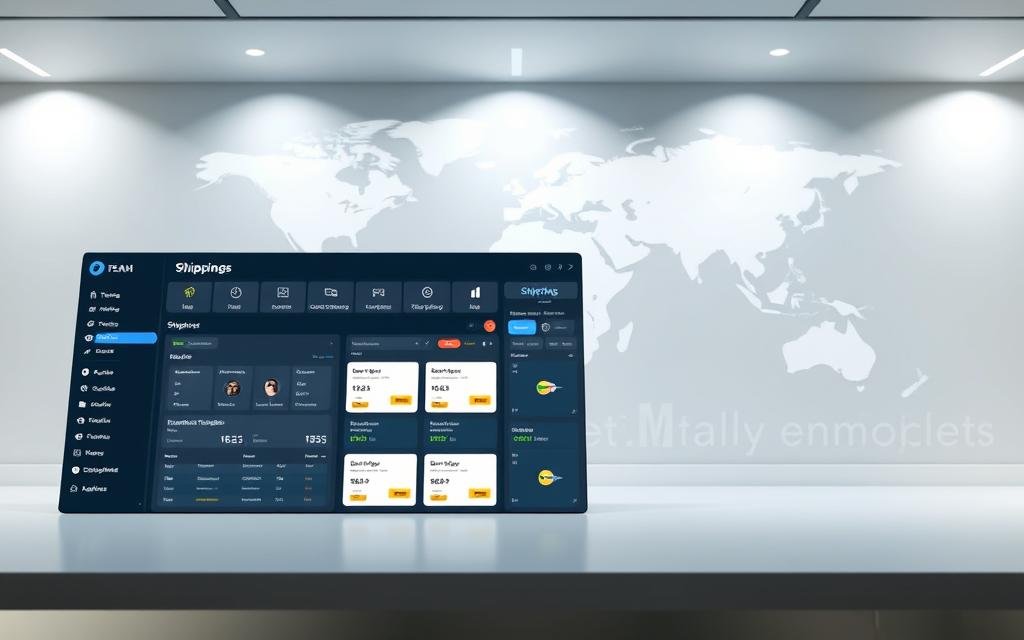Ever thought about how easy shipping could be with the right tools? The e-commerce world is changing fast. Success depends on picking the best E-commerce Shipping Software. I’ll show you how to link online shipping solutions to your site for better logistics and order handling.
With the right shipping management software, you can make shipping smoother for your customers and business. Let’s dive into how to make this happen.
Key Takeaways
- Understanding the importance of integrating shipping tools for better logistics.
- Exploring various E-commerce Shipping Software options available.
- Identifying key features in shipping management software to enhance efficiency.
- Examining the benefits derived from using online shipping solutions.
- Learning integration techniques for platforms like Shopify and WooCommerce.
Understanding E-commerce Shipping Software
E-commerce Shipping Software is a key tool for online stores. It makes shipping easier and boosts logistics efficiency. This software helps me manage shipping better, ensuring a smooth experience for customers.
What is E-commerce Shipping Software?
E-commerce Shipping Software simplifies shipping for online businesses. It connects with different platforms for order processing, label creation, and tracking. Cloud-based shipping software lets me access these tools from anywhere, improving flexibility and speed.
Using e-commerce logistics software helps me work better with shipping carriers. This ensures my operations run smoothly.
Key Features to Look For
When choosing E-commerce Shipping Software, look for these key features:
- Multi-carrier support: Working with various carriers offers flexibility and saves money.
- Real-time tracking: Real-time tracking builds trust with customers and keeps them updated.
- Automated shipping label generation: This feature saves time and cuts down on errors.
- Inventory sync: Syncing inventory with orders reduces mistakes and ensures accurate fulfillment.
Benefits of Using Shipping Software
Using shipping software offers many benefits:
- Time savings: Automating tasks lets me focus on growth.
- Cost efficiency: Choosing the best shipping options can save a lot of money.
- Accuracy: The software improves shipping accuracy, reducing mistakes.
- Improved customer experience: Fast and reliable shipping makes customers happier.
Choosing the Right Shipping Software for My Business
Choosing the right shipping software is a big decision. I look at different options to see if they fit with my business. I want a solution that has all the features I need for smooth operations.
Evaluating Different Options
I’m looking for cloud-based solutions that make shipping easy. There are many options out there. They include:
- Shipping management software with integrated tracking capabilities.
- User-friendly interfaces that make it easy for my team to learn.
- Compatibility with e-commerce fulfillment tools to improve my workflow.
Integration Features to Consider
Integration features are important in my decision. I consider:
- Ease of use: The software should be easy to use, saving time on training.
- Payment processor integration: It should work well with platforms like Square and PayPal.
- Order management systems support: It should work well with my current systems for smooth operations.
By looking at these points, I can find software that meets my needs now and grows with my business.
Setting Up Shipping Software with My E-commerce Platform
Integrating shipping software with my e-commerce platform is key for a smooth order process. It makes logistics more efficient. First, I pick the shipping automation technology that suits my business.
Step-by-Step Integration Process
Here’s how I start:
- I choose and install shipping software that works with my platform.
- I set it up to meet my shipping needs, like choosing carriers and calculating rates.
- I connect it with my inventory system to keep track of stock levels.
- I test it with trial orders to find any mistakes.
- Then, I watch for any issues and fix them.
Common Integration Challenges
Setting up shipping software can be tricky. Data migration and software compatibility are big hurdles. To overcome these, I test thoroughly and get help from vendors.
For more tips on solving these problems, I check out mastering shipping and logistics in e-commerce.
Automating Shipping Processes
In today’s fast world of e-commerce, shipping automation is key to being efficient. It cuts down on manual work, letting me focus on my business’s growth. With the right online shipping solutions, order fulfillment gets faster and more accurate.
How Automation Can Save Time
Automation saves a lot of time. With shipping software, tasks like printing labels and tracking orders become easier. This means fewer errors and quicker orders. It makes logistics smoother, letting me grow my business without hassle.
Tools That Facilitate Automation
Many tools help automate shipping. For example, Shippo works well with BigCommerce, making shipping better. Other great tools include:
- Easyship: Offers many shipping choices and compares prices.
- ShipBob: Makes order and shipping easier with its third-party logistics.
- Stamps.com: Provides accurate postage and quick label printing.
Ensuring Accurate Shipping Rates
Accurate shipping rates are key for my e-commerce business. They keep customers happy and help me make money. I use cloud-based shipping software to get real-time rates from different carriers.
Importance of Accurate Rate Calculations
High shipping costs can make customers leave without buying. That’s why I need to get my rates right. With a good freight management solution, I can adjust rates and keep costs down.
Keeping an eye on shipping costs helps avoid surprises. It also keeps my customers happy, making their shopping better.
Ways to Validate Shipping Rates
To check shipping rates, I use a few methods. I compare prices from different carriers to find the best deals. I also look at past shipping data to spot trends in costs.
Cloud-based shipping software makes this easier. It lets me quickly adjust to any changes in rates.
By always checking and tweaking shipping rates, I can offer great prices. I also look at guides, like this e-commerce shipping software guide. This helps my business stay efficient and focused on customers.
Streamlining Order Management
Keeping track of orders is key for any online store’s success. An order fulfillment system that works well with shipping tech makes it easy. This setup not only makes logistics simpler but also boosts overall efficiency.
Managing Orders Through Shipping Software
Using e-commerce tools in my shipping software helps me manage all orders in one place. I can see order statuses, inventory, and shipping details at the same time. This clear view cuts down on mistakes and miscommunication.
Linking Order Management and Shipping Tools
Connecting my order system with shipping tools makes info flow smoothly. It sends updates to customers about their orders. With strong e-commerce tools, I can make sure orders are delivered on time and customers are happy.
Tracking Shipments Effectively
Shipment tracking is key in today’s logistics world. It connects my business with customers. Real-time updates on orders boost satisfaction and build trust. With tracking in my shipping software, I offer a smooth experience, keeping customers informed and calm.
Importance of Shipment Tracking
Shipment tracking has many benefits. Customers love to track their orders and get updates. This cuts down on questions and worries. It also helps me make better choices, spotting and fixing delivery issues early.
Implementing Tracking Features
To get the most from tracking, I add important features to my software. Here are the must-haves:
- Real-time updates: Keeping customers in the loop with their shipment status.
- Multiple tracking options: Letting customers pick how they get updates, like email or SMS.
- Seamless integration: Making tracking easy to find on my online platform.
These features make a strong tracking system. It improves customer happiness and makes my shipping work better.
Enhancing Customer Experience
In today’s market, keeping customers happy is key to keeping them. Shipping software helps a lot by making shipping smoother and keeping everyone updated. With the right software, I can give my customers the info they need, making their experience better.
How Shipping Software Improves Customer Service
Shipping software makes my customer service top-notch. It sends out updates on orders and when they’ll arrive. Happy customers are less worried and more satisfied. A smooth shipping process makes my brand look good.
Communicating Shipping Information
Keeping customers in the loop is important. I share shipping details at every step of the order. This includes shipping times, tracking numbers, and when they’ll get their stuff. It makes customers feel secure and valued.
Analyzing Shipping Performance
To improve my shipping, I need to look at key performance metrics. These include delivery times, shipping costs, and how accurate orders are. By understanding these, I can make my shipping better and more reliable.
Metrics to Monitor
Tracking shipping performance helps me use analytics tools effectively. I can see trends in delays, check shipping costs, and measure customer happiness. This information helps me make smart choices to improve shipping.
Using Analytics for Shipping Improvement
Data analytics cuts costs and boosts efficiency, leading to better customer service. I can use shipping analytics software for detailed insights. Regularly checking these metrics ensures my shipping keeps getting better.



